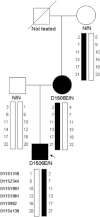Dominantly acting ABCC8 mutations in patients with medically unresponsive hyperinsulinaemic hypoglycaemia
- PMID: 20573158
- PMCID: PMC3375476
- DOI: 10.1111/j.1399-0004.2010.01476.x
Dominantly acting ABCC8 mutations in patients with medically unresponsive hyperinsulinaemic hypoglycaemia
Abstract
Recessive inactivating mutations in the ABCC8 and KCNJ11 genes encoding the adenosine triphosphate-sensitive potassium (K(ATP)) channel subunit sulphonylurea receptor 1 (SUR1) and inwardly rectifying potassium channel subunit (Kir6.2) are the most common cause of hyperinsulinaemic hypoglycaemia (HH). Most of these patients do not respond to treatment with the (K(ATP)) channel agonist diazoxide. Dominant inactivating ABCC8 and KCNJ11 mutations are less frequent, but are usually associated with a milder form of hypoglycaemia that is responsive to diazoxide therapy. We studied five patients from four families with HH who were unresponsive to diazoxide and required a near total pancreatectomy. Mutations in KCNJ11 and ABCC8 were sought by sequencing and dosage analysis. Three novel heterozygous ABCC8 mis-sense mutations (G1485E, D1506E and M1514K) were identified in four probands. All the mutations affect residues located within the Nucleotide Binding Domain 2 of the SUR1 subunit. Testing of family members showed that the mutations had arisen de novo with dominant inheritance in one pedigree. This study extends the clinical phenotype associated with dominant (K(ATP)) channel mutations to include severe congenital HH requiring near total pancreatectomy in addition to a milder form of diazoxide responsive hypoglycaemia. The identification of dominant vs recessive mutations does not predict clinical course but it is important for estimating the risk of HH in future siblings and offspring.
© 2010 John Wiley & Sons A/S.
Figures


Similar articles
-
Diazoxide-unresponsive congenital hyperinsulinism in children with dominant mutations of the β-cell sulfonylurea receptor SUR1.Diabetes. 2011 Jun;60(6):1797-804. doi: 10.2337/db10-1631. Epub 2011 May 2. Diabetes. 2011. PMID: 21536946 Free PMC article.
-
Clinical characteristics of recessive and dominant congenital hyperinsulinism due to mutation(s) in the ABCC8/KCNJ11 genes encoding the ATP-sensitive potasium channel in the pancreatic beta cell.J Pediatr Endocrinol Metab. 2011;24(11-12):1019-23. doi: 10.1515/jpem.2011.347. J Pediatr Endocrinol Metab. 2011. PMID: 22308858
-
Partial ABCC8 gene deletion mutations causing diazoxide-unresponsive hyperinsulinaemic hypoglycaemia.Pediatr Diabetes. 2012 May;13(3):285-9. doi: 10.1111/j.1399-5448.2011.00821.x. Epub 2011 Oct 7. Pediatr Diabetes. 2012. PMID: 21978130
-
[Congenital hyperinsulinism in newborn and infant].Arch Pediatr. 2005 Nov;12(11):1628-35. doi: 10.1016/j.arcped.2005.07.016. Epub 2005 Sep 28. Arch Pediatr. 2005. PMID: 16198094 Review. French.
-
KATP channel mutations in congenital hyperinsulinism.Semin Pediatr Surg. 2011 Feb;20(1):18-22. doi: 10.1053/j.sempedsurg.2010.10.012. Semin Pediatr Surg. 2011. PMID: 21185999 Review.
Cited by
-
Diazoxide-unresponsive congenital hyperinsulinism in children with dominant mutations of the β-cell sulfonylurea receptor SUR1.Diabetes. 2011 Jun;60(6):1797-804. doi: 10.2337/db10-1631. Epub 2011 May 2. Diabetes. 2011. PMID: 21536946 Free PMC article.
-
Hyperinsulinemic hypoglycemia in children and adolescents: Recent advances in understanding of pathophysiology and management.Rev Endocr Metab Disord. 2020 Dec;21(4):577-597. doi: 10.1007/s11154-020-09548-7. Rev Endocr Metab Disord. 2020. PMID: 32185602 Free PMC article. Review.
-
KATP channel mutations in congenital hyperinsulinism: Progress and challenges towards mechanism-based therapies.Front Endocrinol (Lausanne). 2023 Mar 28;14:1161117. doi: 10.3389/fendo.2023.1161117. eCollection 2023. Front Endocrinol (Lausanne). 2023. PMID: 37056678 Free PMC article. Review.
-
Genotype-histotype-phenotype correlations in hyperinsulinemic hypoglycemia.Histol Histopathol. 2024 Jul;39(7):817-844. doi: 10.14670/HH-18-709. Epub 2024 Jan 12. Histol Histopathol. 2024. PMID: 38305063 Review.
-
Somatostatin analogues for the treatment of hyperinsulinaemic hypoglycaemia.Ther Adv Endocrinol Metab. 2020 Dec 2;11:2042018820965068. doi: 10.1177/2042018820965068. eCollection 2020. Ther Adv Endocrinol Metab. 2020. PMID: 33329885 Free PMC article. Review.
References
-
- Ashcroft FM. Adenosine 5′-triphosphate-sensitive potassium channels. Annu Rev Neurosci. 1988;11:97–118. - PubMed
-
- Aguilar-Bryan L, Bryan J. Molecular biology of adenosine triphosphate-sensitive potassium channels. Endocr Rev. 1999;20:101–135. - PubMed
-
- Menni F, de Lonlay P, Sevin C, et al. Neurologic outcomes of 90 neonates and infants with persistent hyperinsulinemic hypoglycemia. Pediatrics. 2001;107:476–479. - PubMed
-
- Thomas PM, Cote GJ, Wohllk N, et al. Mutations in the sulfonylurea receptor gene in familial persistent hyperinsulinemic hypoglycemia of infancy. Science. 1995;268:426–429. - PubMed
-
- Thomas P, Ye Y, Lightner E. Mutation of the pancreatic islet inward rectifier Kir6.2 also leads to familial persistent hyperinsulinemic hypoglycemia of infancy. Hum Mol Genet. 1996;5:1809–1812. - PubMed
Publication types
MeSH terms
Substances
Grants and funding
LinkOut - more resources
Full Text Sources

